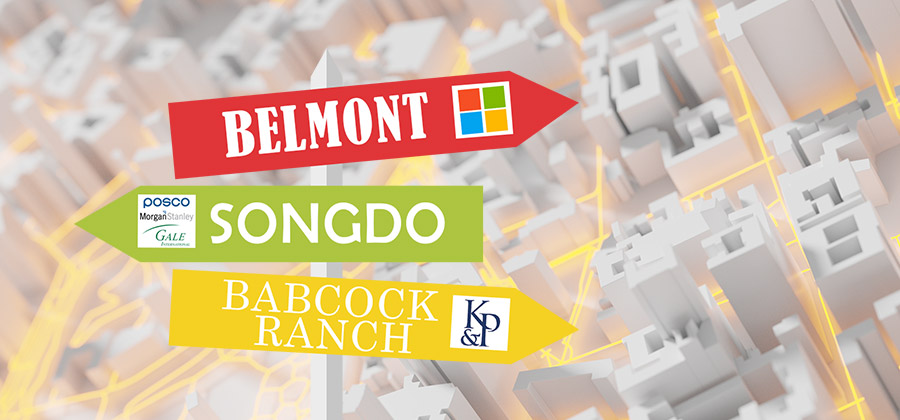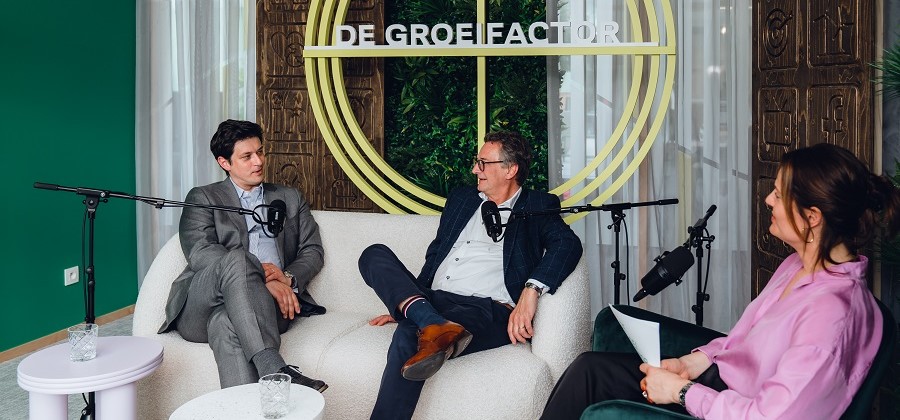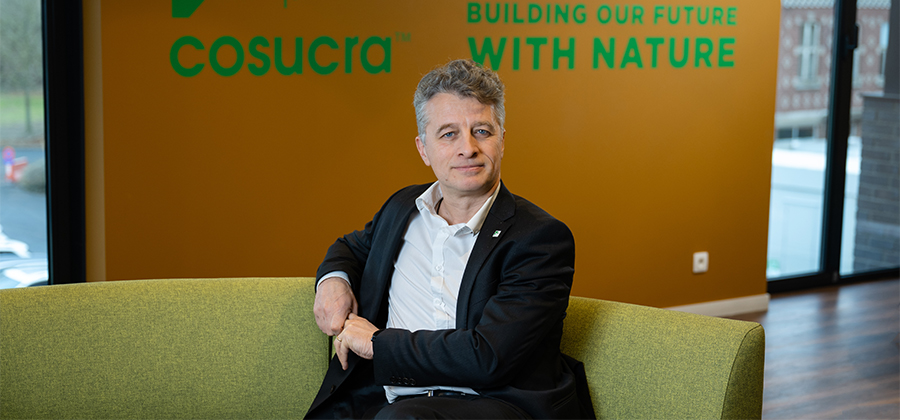A number of tech giants are now planning to build their own private cities. As these futuristic, digitally-equipped towns will showcase many innovations, the projects may well help to get Smart Cities up and running faster.

Whether we are talking about Microsoft founder Bill Gates, who recently announced plans to build a digital city in Arizona called Belmont, or Eric Schmidt, Executive Chairman of Google parent Alphabet, who recently unveiled the Sidewalk Toronto project, Web bosses seem to have been struck by a sudden passion for town planning.
Behind these projects, which are still very much in their infancy, there is however much at stake. The Smart City represents a huge future market which will soon gather pace all over the planet. Building their own cities, and injecting substantial funds, enables the major Internet players to experiment in real conditions, designing, testing, labelling and demonstrating to the wide world innovative technologies with the potential to help run the planet's megacities in the near future. However, it must be said that they are jumping on the bandwagon rather than leading the line, since a number of high-tech model cities constructed with private-sector money already exist in Asia and the American continent. So will all these projects really foster the speedy emergence of Smart Cities? From a purely technological point of view, this would appear a safe bet.
A full-on Smart City?
In South Korea, not far from Seoul, the futuristic city of Songdo has been built – at a cost of $35 billion – entirely with private funds. Covering 610 hectares and stuffed full of new fully-digitalized apartment buildings, Songdo boasts cutting-edge digital technology and an impressive set of environmentally-friendly systems. This fully operational Smart City, with 120,000 residents, is several steps ahead of its rivals. The local authority has implemented digital technology-based initiatives designed to optimise the way the city works and streamline the daily lives of its inhabitants. For example, auto traffic is managed using a state-of- the-art system. Every car licence plate is scanned as soon as it leaves its parking spot, and the data is then sent to a management platform that calculates the number of drivers on the road, or about to move out on to the road, in order to optimise traffic flows in real time. In the same vein, some 500 cameras are in place, backed up by an arsenal of sensors installed on street furniture, for the purpose of sending data on the number of buses in service and their precise location to the management platform.
The results are commensurate with the resources that have been deployed. There are no more traffic jams. Public transport is never late and always safe. Police can access the data gathered by the sensors and cameras so as to get to an incident as soon as it occurs. Songdo also stands out from its rivals when it comes to environmental responsibility: 99%of the city's parking is underground, and household waste is taken directly from homes and piped through to the recycling plant. The rainwater collection and filtration system is located beneath the golf course and all the buildings have solar panels. In addition, the city authority keeps a close eye on the energy consumption of each building with a view to limiting expenditure and pollution and redistributing any surplus.
In fact, Songdo can claim to top the list of Smart Cities, having amply demonstrated its ability to provide a connected response to urban problems. Nevertheless, the way it operates still raises some questions. As a privately-owned city in the hands of a consortium of investors, it fails to implement such democratic principles as data transparency and to foster civic dialogue. However, while some observers might be worried about the central surveillance aspects of Sondo's organisation, the town is exemplary from a technological point of view and its model may soon be exported throughout Asia. But it does highlight one rather disappointing aspect: it seems easier to build a Smart City from scratch than transform an existing town.
Building everything from the ground up
In the south of Florida, former American football player-turned multi-millionaire Syd Kitson is bringing to life Babcock Ranch, a futuristic fully-connected and entirely 'green' town. The electricity grid is 100% solar-powered, fed by a plant located on the edge of town, and the streets are lined throughout with photovoltaic panels, each feeding one house. As the owner of this miniature Smart City covering 370 square kilometres, Syd Kitson has decided to implement a number of measures designed to boost the environmental aspects of the venture. Petrol-driven cars are not allowed inside Babcock Ranch, electric vehicles are tolerated but quotas are imposed.
The idea is not only to avoid carbon dioxide emissions but also to keep the number of vehicles stable. The circular economy takes priority: fruit and vegetables are grown in nearby fields and orchards and are sold in local shops and used in the town's restaurants. If the whole approach feels rather authoritarian this is no doubt because Kitson is actually the sole owner of his town. But the results are undisputable: there is no pollution. By designing and building Babcock Ranch from A to Z and implementing strict rules of operation, Kitson has achieved much better than average outcomes and demonstrated that this method works.
In the same vein, but on a very different scale, Bill Gates' real estate investment group Belmont Partners is preparing to start building Belmont, a city that will have technology embedded in its DNA. Belmont Partners has just acquired a vast area of land in Arizona, around a hundred kilometres from Phoenix. Covering an area as large as Paris, the new town is intended to be a real laboratory for Smart City experimentation, testing out the latest technologies for self-driving cars and implementing a range of innovations involving incorporating green spaces into the cityscape, using renewable sources of energy for power and drawing on local food supply chains.
Bill Gates also intends to draw up a digitally innovative and environmentally-friendly roadmap for tomorrow's smart cities. And he reckons that it is easier to test and integrate the technologies which will be used in Smart Cities by building a new town rather than transforming an existing one. Existing cities usually have a long architectural legacy to cope with. In theory a blank canvas is easier to work with.
Google is dancing to the same tune. Sidewalk Labs, Alphabet's Smart City subsidiary, has announced a ground-breaking partnership with the city of Toronto to build a mini smart city focusing entirely on digital technologies. With this venture Google is clearly demonstrating its objectives in the smart city sphere. The Internet giant is planning to set up its own testing centre to hone technologies that work well in practice and can be marketed.
Public-private collaboration
Clearly a Smart City is not the exclusive province of governmental authorities. If it is to work properly, the private sector will have to come in and supply the necessary technologies. Public-private collaboration therefore seems essential and the Internet giants have clearly grasped this fact. Making Smart Cities the norm for urban development in the 21st century will be a huge challenge.
Let us hope that such cities, constructed from scratch and based on digital innovation, will in turn foster the emergence of a truly civic Smart City. After all, smart technology cannot be the only criterion for a functioning town in the years to come.
(Source: BNP Paribas – L’Atelier)
16.12.2024
The digital divide persists
“It's not just the elderly who lack digital skills, young people and workers are also affected,” says Linde Verheyden, Director Public Affairs at BNP Paribas Fortis and Chair of DigitAll.
Despite the acceleration in digitalisation, many people are being left behind. In Belgium, 40% of the population between the ages of 16 and 74 are at risk of digital exclusion. Although older people are often seen as the most vulnerable group, younger people are also struggling in the digital age. Among young people aged between 16 and 24, almost a third lack basic digital skills, with a peak of 52% among those with a low educational attainment.
Figures that are surprising to say the least, considering young people grow up surrounded by digital tools.
"People often assume that young people are digital natives because they are adept at using social media. But making a TikTok video or scrolling through your Instagram feed doesn't necessarily mean you know how to carry out online banking transactions or complete an application form.
Does poverty play a significant role in the digital divide?
"Absolutely. For 25% of people living in poverty, a smartphone is their only digital device. Although they provide a basic form of access, smartphones are often inadequate for important tasks such as preparing a CV or filing a tax return. Without a computer or a stable internet connection, many digital opportunities remain out of reach for those who don't have access to these tools.
What are the other reasons for this digital divide?
"People often lack the necessary basic digital skills because they never learned them. They may not know how to use a search engine, attach a file to an e-mail, or download an app. Without this knowledge, the digital world becomes inaccessible. Furthermore, there is also the issue of digital stress. Many people worry about making mistakes, being hacked, or their privacy. Some people deliberately choose not to use digital services even though they have the skills. Technology instils a sense of distrust and unrest in them, creating a significant barrier.”
How can companies help close this gap?
"Companies can play a key role on several levels. In addition to being a social problem, digital exclusion is also an economic challenge. Today, less digitally adept individuals are both customers and potential employees. Being aware of this as a company is the most important first step. But it’s also essential to provide support to your staff. For example, employees at the municipal parks and greenery service in Ghent received training on how to file their tax returns online. These kinds of initiatives give people practical skills and confidence. In addition, companies need to do a digital check. To measure is to know. Just because someone uses a laptop daily, it doesn’t mean they have digital skills."
What does BNP Paribas Fortis do specifically to promote digital inclusion?
"We have launched several initiatives. In 2020, we established DigitAll, a platform for sharing knowledge and best practices around digital inclusion. Today, we bring together more than 130 organisations. DigitAll has developed a range of tools, including a checklist that companies can use to test how accessible their apps and websites are. A simple interface can make the difference between joining or dropping out for people who are less digitally adept. Since 2021, the bank has also supported a chair at the VUB that investigates the link between digital inclusion and human rights."
How important are tools in bridging the digital divide?
"User-friendly tools are a must. We have partnered with Emporia, a manufacturer of user-friendly smartphones for the less digitally adept. We pre-install our app for customers who buy one of their smartphones."
We mentioned digital stress earlier. How can you mitigate this?
"With awareness campaigns. We want our customers to use our tools with confidence. The bank also takes its less digitally adept customers into account. Thanks to our partnership with bpost, all our customers can go to their local post office for all basic banking transactions."
Do companies stand to benefit from promoting digital inclusion?
"They do. Digital inclusion requires a sustained effort from all stakeholders, including governments and educational institutions. No one should be left behind. Companies that act now can contribute to a more inclusive society while also securing their own future in an increasingly digital world.”
“Without key digital skills, many digital opportunities remain out of reach.”
“A simple interface can make the difference between joining or dropping out for people who are less digitally adept.”
“Limited digital skills remain an obstacle to closing the digital divide.”
Linde Verheyden, Director Public Affairs at BNP Paribas Fortis and Chairman of DigitAll
10.06.2024
Electronic invoicing between companies to become mandatory
The bill to introduce this obligation in Belgium has been submitted to the Federal Parliament. If the draft bill is approved, B2B e-invoicing will become mandatory from 1 January 2026. Our experts explain why Belgium wants to introduce these new rules, what the implications are for your company and how we can better support you.

“The bill is consistent with international developments and initiatives at the European level,” says Nicolas De Vijlder, Head of Beyond Banking at BNP Paribas Fortis. "Europe's ambition is a harmonised digital standard. Structured e-invoicing between companies will also reduce the administrative burden of invoicing, enabling companies to work more efficiently and increase their competitiveness. The automation of VAT declarations will also help governments prevent tax fraud and adjust economic policies based on more qualitative data.”
Evolution rather than a revolution
“The new legislation is an evolution rather than a revolution,” adds Erik Breugelmans, Deputy Managing Director at BNP Paribas Factoring Northern Europe. "Digitalisation is becoming pervasive at all levels of society, as we have seen with the increase in electronic payments, as well as the additional obligations in recent years regarding electronic invoicing to the government. In this sense, the bill for mandatory electronic invoicing between companies is a logical next step. Our bank is happy to contribute to this process, although we do not intend to offer the same services as accounting software or fintechs. However, we are happy to help our customers with payments and financing."
The impact on businesses
“Customers need to be aware that the new regulations will have an impact on their internal and external processes,” continues Erik Breugelmans. "The majority of Belgian companies mainly serve an international market, which means that the introduction of electronic invoicing will be more complex for them than for companies operating in the domestic market. As the legislation will be introduced in one go, they need to start preparing now."
“The new rules will affect a company’s accounting department as well as its IT department,” emphasises Nicolas De Vijlder. "The procedural requirements are key, otherwise the automated process will not work. However, one of the main benefits of advanced automation is that everything can be done faster and more efficiently. The time between sending an invoice and paying it will be shorter and cash flows more predictable. In addition, it will also reduce the risk of error and fraud, as all transactions will pass through a secure channel."
Ready to offer you even more and better support
“Thanks to the far-reaching digitisation resulting from the new regulations, we will be able to further optimise payments,” concludes Erik Breugelmans. "As a bank, we need to finance our customers’ receivables as quickly and efficiently as possible, so that they have easier access to their working capital. In addition, because we have already gone through an entire process in terms of large-scale automation, we will be able to adapt quickly to the new rules. We can also draw on the expertise of the BNP Paribas Group, which is currently developing an e-invoicing solution for large companies."
Want to know more?
Listen to the episode on B2B e-invoicing :
16.05.2024
Kazidomi: a healthy online supermarket
A subscription to build customer loyalty, reinvent yourself in times of crisis and buy better: Emna Everard saw that as exactly the right way to launch and maintain her Brussels-based start-up.
Born into a family of dietitians, Emna Everard knows what it means to eat healthily. "At the age of 12, I was already deciphering packaging labels. My dream was to open a supermarket one day where you could shop with your eyes closed", she recalls.
And because Everard has entrepreneurship in her bones, that’s exactly what she did. In 2016, just before the end of her university studies, she launched the “healthiest online supermarket on the market”: Kazidomi. Her standards are high, both in terms of composition and taste. Kazidomi selects products carefully, enabling its customers to buy healthy, mainly organic, plant-based products with complete confidence.
The loyalty programme
Six months after its launch, Kazidomi’s growth is accelerating thanks to the launch of its loyalty programme. A 59 euro subscription offering 20–50% discounts on all food, cosmetics or care products available online. Profitability and savings guaranteed.
This was followed by a first fundraising of €50,000 in 2017. Kazidomi is growing, expanding the size of its stock and developing its marketing. Everard hired her first two employees. Sales grew rapidly and literally exploded during the COVID-19 pandemic. "Consumers suddenly had time to think about their health and well-being and were doing most of their shopping online," she adds.
How did you reinvent yourself?
The post-crisis period was a turning point. "Kazidomi had to reinvent itself. We wanted to have financial stability and avoid any dependence on external resources," continues Everard. Together with her teams, she looked at their cost structure, operational efficiency and marketing. After these reflections, the aim was no longer growth at any price, but the company's long-term viability and financial health, thanks to an intelligent reorganisation.
Two acquisitions would subsequently enable Kazidomi to boost its growth, creating significant synergies: "Smart Fooding" in August 2022 and "Bébé au Naturel" a few months later, a business specialising in healthy products for babies and their parents. "With Bébé au Naturel, we doubled the volume of orders sent out," adds Everard. "This has allowed us to get a better rate from our carriers and reduce costs."
A responsive and attentive bank
As the Brussels start-up’s bank, BNP Paribas Fortis granted it three loans for its launch, between 2016 and 2019. This support came naturally, with Kazidomi’s commitments in terms of Environmental, Social and Governance (ESG) objectives perfectly aligned with the bank’s strategy. "We joined the BNP Paribas Fortis Innovation Hub programme and our relationship manager – who knew the start-up environment extremely well – was immediately enthusiastic and very attentive. He believed in our project, followed it closely, advised us to participate in a series of events to meet other players whose background and profile would be of interest for us," explains the Entrepreneur of the Year 2019.
But the support didn't stop there. "In December 2022, it was thanks to BNP Paribas Fortis, among other things, that we were able to acquire “Bébé au Naturel”. Start-ups like Kazidomi need a high level of responsiveness from their bank. When there is a company to buy, or another opportunity, things have to move fast. Analysis of the file, provision of funds: BNP Paribas Fortis has always been responsive and enthusiastic and has supported us in 99% of our requests," says the CEO enthusiastically.
|
Eight years since launching, Kazidomi today has 4,000 products that it delivers across Europe. The Belgian start-up makes 90% of its sales on its website and 10% via external resellers, such as Delhaize. Kazidomi has also launched its own brand “Kazidomi”, which has 200 products on offer. By working directly with producers, we can offer the best possible quality products at the best price. |
Kazidomi is ready to change the world. Discover even more inspiring entrepreneurial stories.
14.05.2024
Less CO2 and healthier food
Cosucra is investing in the decarbonisation of its production processes. Their focus is on using fibre and plant-based protein from chicory and peas for a healthy and less polluting diet.

Belgium’s Hainaut-based Cosucra has been operating since 1852. The company is quite small with 365 employees, but its activities have evolved over time. From the 1980s onwards, sugar beet processing gave way to chicory and yellow peas. Also, sugar was replaced by inulin and pea protein.
"Many families lack the time to put a fresh meal on the table every day. With our products, the industry can offer them easy, quick and nutritious meals," says Eric Bosly, CEO of Cosucra. "Nutritionists stress the importance of fibre and plant proteins for health, and such a diet has a positive impact on our carbon footprint."
New investors
To take their decarbonisation a step further, in 2023, the company launched a seven-year investment plan worth EUR 150 million. “We are keenly aware of the climate crisis, so we wanted to make this transition fast,” says Bosly. “That's why we brought three investors on board who share our values and are willing to commit in the longer term.”
Long-term relationship
Cosucra and BNP Paribas Fortis have a long-standing partnership. "The bank has supported us in expanding to Denmark and the United States. It's of great value to have the same contact person for setting up the financial structure of subsidiaries, opening accounts abroad, etc. We also meet regularly, which means we can count on the expertise of teams specialised in the food industry. Their macro vision complements that of our local account managers who know our business well."
Same market conditions
Cosucra’s efforts will result in a 55% reduction in CO2 emissions within three years. Yet, decarbonisation is just one of Bosly’s bold ambitions. "We are pushing for the same market conditions as animal proteins. Why, for example, is 20 per cent VAT levied on pea-based milk while for cow’s milk, this figure is under 6 per cent? Plant-based products are also more expensive because you can't achieve economies of scale due to the lower quantities required. If you consider all the “negative external effects” of animal products on human health and the environment, our sector deserves support until we reach a certain scale."
Change of mindset
The entrepreneur also laments how the retail sector uses meat as a decoy product, lowering its margins to offer consumers an attractive price. "In times of inflation, that price difference is all the more detrimental to us. This is why a change of mindset is essential. Nutritionists say that a weekly serving of just 200 to 250 grammes of meat is enough to get the nutritional benefits with no negative impact. But at the moment, most Belgians consume 200 grammes of meat per day."
Bosly also cites competition from imported agricultural products as an obstacle.
Cosucra is ready to change the world. Discover even more inspiring entrepreneurial stories.
"The European Green Deal aims to reduce inputs by half, leading to the ban of many herbicides, among other things. Farmers should be supported in this transition. And a company like Cosucra, which buys chicory and peas within a 200-kilometre radius, is not on an equal footing with strong Chinese competition."
